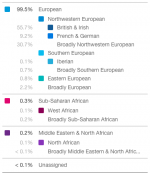jamt
Regular Member
- Messages
- 34
- Reaction score
- 9
- Points
- 0
- Ethnic group
- Euro-Caribbean
- Y-DNA haplogroup
- Q1
- mtDNA haplogroup
- H1a
First post! Hello!
I've been using 23andme to get the information for my grandparents generation (2 stand ins with siblings because my grandfathers were dead).
So, my father's father's brother turns out to be Q1a. I know there's a chance they aren't full siblings, and I've never heard anything of the sort, but I may get my father tested eventually and see if it's different.
Based on my knowledge of our family history, our paternal lineage should be British - as the patriarch came to the British Colony of Barbados in the 1600s, and was a Lieutenant - obviously British. Can't say I'm really well versed in the genetics as I'd like... so, why is our Y-DNA Q1a instead of a 'more British' Y-DNA?
I've been using 23andme to get the information for my grandparents generation (2 stand ins with siblings because my grandfathers were dead).
So, my father's father's brother turns out to be Q1a. I know there's a chance they aren't full siblings, and I've never heard anything of the sort, but I may get my father tested eventually and see if it's different.
Based on my knowledge of our family history, our paternal lineage should be British - as the patriarch came to the British Colony of Barbados in the 1600s, and was a Lieutenant - obviously British. Can't say I'm really well versed in the genetics as I'd like... so, why is our Y-DNA Q1a instead of a 'more British' Y-DNA?


